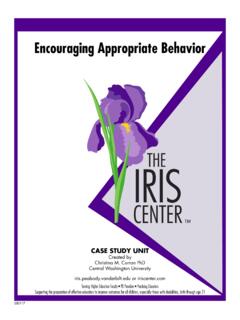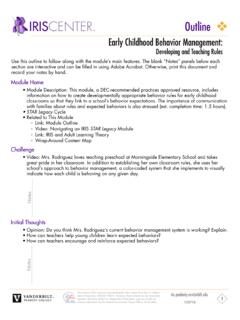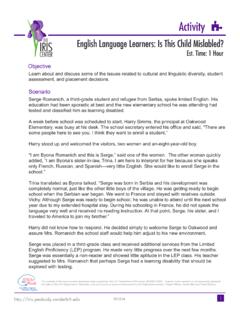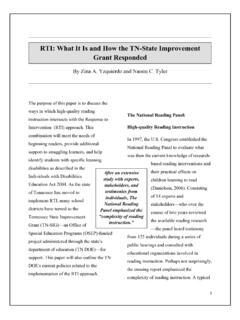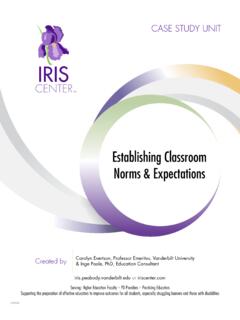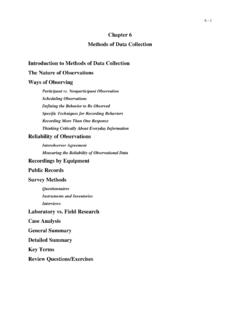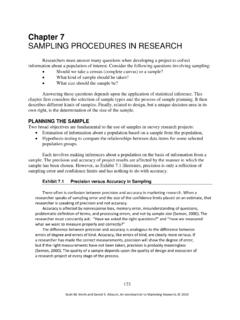Transcription of Defining BEHAVIOR - Vanderbilt University
1 DefiningBEHAVIORC reated bySara C. Bicard, Auburn University at MontgomeryDavid F. Bicard, BEHAVIOR Analysts of Central Alabama, LLC The IRIS #H325F0600031 : PageIntroduction ..3 Case Study Level A, Case 1 ..5 Case Study Level A, Case 2 ..6 Case Study Level B, Case 1 ..7 Case Study Level B, Case 2 ..8 Case Study Level C, Case 1 ..9 Case Study Level C, Case 2 ..10 STAR Sheet: Overview ..12 STAR Sheet: Use Observable Terms ..15 STAR Sheet: Use Measurable Terms ..17 STAR Sheet: Use Positive Terms ..19 STAR Sheet: Be Clear, Concise, and Complete ..21 To cite this case study unit: Bicard, S. C, Bicard, D. F., & the IRIS Center. (2012). Defining BEHAVIOR . Retrieved on [month day, year,] from an Instructor s Guide to this case study unit, please email your full name, title, and institutional affiliation to the IRIS Center at contents of this case study were developed under a grant from the Department of Education, #H325F060003.
2 However, those contents do not necessarily represent the policy of the Department of Education, and you should not assume endorsement by the Federal Government. Project Officer, Shedeh :// .. To contact the IRIS Center:IRIS-CentralModules and Materials DevelopmentNaomi C . Tyler, Ph .D. Vanderbilt UniversityPhone: (615) 343-6006 (800) 831-6134 FAX: (615) 343-5611 EMAIL: iris@ Vanderbilt .eduIRIS-WestTechnical Assistance and TrainingDeborah D . Smith, Ed .D . Claremont Graduate UniversityPhone: (909) 607-8982 (866) 626-IRIS [4747]FAX: (909) 607-0959 EMAIL: iris@cgu .eduIRIS-EastPartnerships and Consumer InputJudy Smith-Davis, Ph .D . Washington, DC Phone: (703) 239-1557 EMAIL: judysd@cox.
3 NetIntroductionDefining BehaviorBefore they begin instruction, teachers must define the skills and knowledge that they expect students to learn. Similarly, teachers must identify the behaviors they expect their students to engage in during instruction. When students do not engage in these expected behaviors, teachers need to be able to objectively define the expected behaviors and the behaviors that need to be changed. Once defined, these behaviors can be is BEHAVIOR ? BEHAVIOR is something that a person does that can be observed, measured, and repeated. When we clearly define BEHAVIOR , we specifically describe actions ( , Sam talks during class instruction). We do not refer to personal motivation, internal processes, or feelings ( , Sam talks during class instruction to get attention).
4 Why define BEHAVIOR ?A prerequisite for measuring BEHAVIOR is to be able to operationally define the target BEHAVIOR ( , the behav -ior to be changed or the problem BEHAVIOR ) as well as the desired BEHAVIOR . Being able to operationally define a BEHAVIOR is important because it helps teachers to: Collect data on the BEHAVIOR , either by observing the student or by asking others about the student Collect accurate information about when the BEHAVIOR occurs Optimize the available services or supports for data collection Focus on the interaction between the environment and student instead of assuming that innate issues are the BEHAVIOR s source ( , He s a troubled kid.)
5 Describe what they want their students to do in an unmistakable manner so that others can assist in their efforts Design an appropriate intervention Determine whether the BEHAVIOR has changed once an intervention has been implemented Write individualized education program (IEP) behavioral goals and objectives, conduct functional BEHAVIOR assessments, and communicate with others ( , parents, other teachers, guidance counselors)Note: This case study unit is concerned solely with Defining BEHAVIOR . To learn about methods for measuring BEHAVIOR and about conducting a functional behavioral assessment, see the following IRIS resources:Case Study Unit: Measuring BehaviorModule: Functional Behavioral Assessment: Identifying the Reasons for Problem BEHAVIOR and Developing a BEHAVIOR Plan3 , T.
6 (2008). Best practices in problem analysis. In A. Thomas & J. Grimes (Eds.), Best practices in school psychology V (pp. 159 176). Bethesda, MD: National Association of School , J. O., Heron, T. E., & Heward, W. L. (2007). Applied BEHAVIOR analysis (2nd ed.). Prentice Hall: Upper Saddle River, , T. C., Chafouleaus, S., M., Christ, T., Briesch, A., & LeBel, T. (2009). The impact of item word-ing and behavioral specificity on the accuracy of direct BEHAVIOR ratings (DBRs). School Psychology Quarterly, 24(1), 1 , J., Ferro, J., Liaupsin, C. J., & Lane, K. L. (2007). Functional BEHAVIOR assessment and function-based intervention: An effective practical approach. Prentice Hall: Upper Saddle River, , J.
7 C., VanDerHeyden, A. M., & Gilbertson, D. (2004). Troubleshooting behavioral interventions: A sys-tematic process for finding and eliminating problems. School Psychology Review, 33, 363 383. 4 BEHAVIOR Level A Case 1 BackgroundStudent: GreysonAge: 10 Grade: 4thScenarioMr. Robertson is a member of the student support team at Delroy Elementary School. He and his colleagues have reviewed a pre-referral intervention form for Greyson. However, they are not quite sure why his teacher, Mrs. Nichols, has referred him. Mrs. Nichols stated on the referral form that Greyson s problem BEHAVIOR is that he reads below grade level. She states that the desired BEHAVIOR is for Greyson to read better 100% of the time.
8 When asked to clarify her description of Greyson s target and desired behaviors, Mrs. Nichols states that Grey-son is reading at a first-grade level and needs to read grade-level text Strategies Use positive terms Use measurable terms Be observable Be clear, concise, and complete! Assignment 1. Read the STAR Sheet Overview. 2. Read the STAR Sheets for the strategies listed above. 3. Use the table below to complete the following: Identify Ms. Nichols definitions of Greyson s target BEHAVIOR and the desired BEHAVIOR . Write each in the designated cell in the first row of the table. For each definition, determine whether it meets each of the listed criteria.
9 If it does, circle the check mark, if not, circle the x. CriteriaTarget BehaviorDesired BehaviorStated in Positive Terms Measurable Observable Clear, Concise, and Complete 5 BEHAVIOR Level A Case 2 BackgroundStudent: Ra lAge: 12 Grade: 6thScenario I ain t doin that! Ra l yells before he walks out of the classroom. Mrs. Banks, his teacher, steps into the hallway and says, Ra l, you need to cool off then come back inside. Ra l shrugs and replies, Aw, man. He looks around and begrudgingly walks back into the classroom. Ra l has received ten office discipline referrals (ODR) in the past three weeks.
10 Mrs. Banks stated on the ODRs that Ra l is disrespectful. The Schoolwide Posi-tive BEHAVIOR Support Team has looked at Ra l s ODRs to determine what the issue is and which intervention might prove Strategies Use observable terms Use measurable terms Be clear, concise, and complete Use positive terms! Assignment 1. Read the STAR Sheet Overview. 2. Read the STAR Sheets for the strategies listed above. 3. Identify Mrs. Banks definition of Ra l s target BEHAVIOR . Is the definition stated in positive terms? Is it measurable, observable, and clear, concise, and complete? 4. What additional information should the Schoolwide Positive BEHAVIOR Support Team seek from Mrs.

